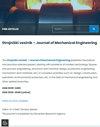The Effect of the Thickness-to-Die Diameter Ratio on the Sheet Metal Blanking Process
IF 1.2
4区 工程技术
Q3 ENGINEERING, MECHANICAL
Strojniski Vestnik-Journal of Mechanical Engineering
Pub Date : 2017-09-14
DOI:10.5545/SV-JME.2016.4272
引用次数: 7
Abstract
The blanking process has a wide range of usage in the sheet metal production industry. The effectiveness of the process rests on the balance between the surface quality of the blanks and energy conservation during the process. The effects of different process parameters on surface quality and energy efficiency have been studied by researchers, but there is a gap concerning the effect of the thickness-to-die diameter ratio on surface quality and energy efficiency. In this study, four different thickness-to-die diameter ratios (t/Dm=1/5, t/Dm=1/10, t/Dm=1/30 and t/Dm=1/50) with five different clearances (1 %, 3 %, 5 %, 10 %, and 20 % of thickness) were used to blank 2-mm-thick round workpieces made of AISI 304 stainless steel. Both experimental and FEM studies were accomplished. A special die set was manufactured and a hydraulic press was used for experimental studies. For FEM studies, Deform-2D was used. Investigations were made on the effects of different thickness-todie diameter ratios on the blanking force, cutting energy crack propagation angles, and zone distribution related to surface quality. Results gathered from FEM simulations and experimental studies were coherent with each other.厚模直径比对板料冲裁工艺的影响
冲裁工艺在钣金生产行业中有着广泛的应用。该工艺的有效性取决于在毛坯表面质量和过程中节能之间的平衡。不同工艺参数对表面质量和能效比的影响已有研究,但厚度与模具直径比对表面质量和能效比的影响还存在空白。在本研究中,采用四种不同的厚度与模具直径比(t/Dm=1/5, t/Dm=1/10, t/Dm=1/30和t/Dm=1/50)和五种不同的间隙(厚度的1%,3%,5%,10%和20%)对AISI 304不锈钢制成的2mm厚圆工件进行毛坯。完成了实验和有限元研究。制作了一套特殊的模具,并使用液压机进行了实验研究。在有限元研究中,使用了Deform-2D。研究了不同厚模直径比对冲裁力、切削能、裂纹扩展角以及与表面质量相关的区域分布的影响。有限元模拟结果与实验结果吻合较好。
本文章由计算机程序翻译,如有差异,请以英文原文为准。
求助全文
约1分钟内获得全文
求助全文
来源期刊
CiteScore
3.00
自引率
17.60%
发文量
56
审稿时长
4.1 months
期刊介绍:
The international journal publishes original and (mini)review articles covering the concepts of materials science, mechanics, kinematics, thermodynamics, energy and environment, mechatronics and robotics, fluid mechanics, tribology, cybernetics, industrial engineering and structural analysis.
The journal follows new trends and progress proven practice in the mechanical engineering and also in the closely related sciences as are electrical, civil and process engineering, medicine, microbiology, ecology, agriculture, transport systems, aviation, and others, thus creating a unique forum for interdisciplinary or multidisciplinary dialogue.

 求助内容:
求助内容: 应助结果提醒方式:
应助结果提醒方式:


